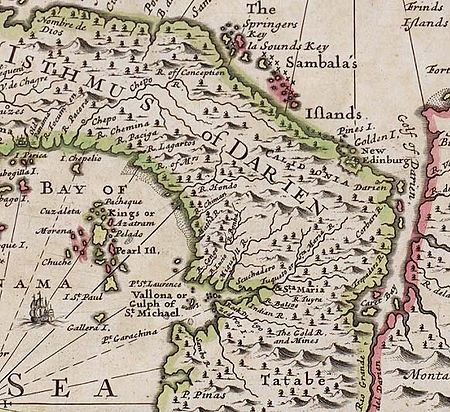The Darien Scheme was an attempt to create a Scottish colony. The scheme intended to create ‘Caledonia’ on the isthmus of Panama (Darien). This would create a colony with land passage from the Atlantic to the Pacific Ocean, providing an economic advantage for the kingdom of Scotland as global trade began to increase. The first expedition to Darien was in 1698. It was followed by resupply the following year. The scheme was a disaster and caused financial loss for many of its backers.
New Edinburgh established as a settlement
The Darien Scheme saw a first expedition set up New Edinburgh on the now Panamanian coast. The settlement struggled to trade with local tribes who were not hostile but showed no interest in the goods the settlers had brought. News from Darien back to Scotland was sent through the occasional vessel that entered the bay. Most of the letters that were sent back gave the impression that the colony was doing well. In reality, it was far from successful.
Darien Scheme in trouble
Settlers had cleared some land to grow crops. They also received some gifts of food from local tribes. Most of the food was retained by the captains of the ships though. The conditions on land were unhealthy. Diet was poor and malaria kicked in. Mortality rates rose to above 10 per day, a high number for a colony of 1200.
Desperate, a ship was sent to Jamaica to seek assistance from the English colony. The English refused to help as King William forbade any actions that may anger the Spanish. Following this, the survivors boarded two ships and made for New York. Here they discovered that supplies were already on the way to the colony. Attempts were then made to return.
Resupply of the Darien region
A resupply convoy set of in 1699 totally unaware of the poor condition of the colony. Four ships set sail from the Clyde carrying 1000 new settlers. These people believed Darien to be working and expected to find New Edinburgh a bustling new community. Instead they found the burnt out remains of one of the resupply ships and most of the huts in ruins. The settlers who were there were low in number.
These settlers had little choice but to try and rebuild New Edinburgh as quickly as they could. Shelter was needed for the 1000 new settlers and defences were important given the proximity of the Spanish and native tribes.
Conflict with Spain
A clash with the Spanish was almost inevitable. It came in January 1700. An officer of the company had been sent to bolster the leadership. Unlike those already there, he was motivated and committed to action. Alexander Campbell of Fontab led an attack on a Spanish stockade. The attack was successful but Fontab was injured and suffered from fever. The Spanish, though also ill with fever, counter attacked. The colony stood little chance.
Failure of the Darien Scheme
A surrender was agreed between the colonists and the Spanish. The colony would be abandoned with the Scots allowed to leave with their guns. Only around ten percent of the 2500 settlers ever made it home. The investment in the Darien Scheme had been huge by lowland families. Worse still, the Company of Scotland that financed the Scheme was backed by around a fifth of money in circulation in Scotland. The collapse of the colony rendered shares in the company worthless and led to a collapse of the Scottish lowlands economy.
The failure of the Darien Scheme contributed to the Act of Union that followed in 1707. Opposition to the Act was muted as economically the Scots were now much more reliant on England.

Recommended Links on the Darien Scheme
Glasgow University Library. The Darien Scheme. Contains many sources on the scheme, including the image above from Rev. Borland’s memoir.
Further Reading on the British Empire
Making of the United Kingdom
Making of the United Kingdom unit homepage – Glorious Revolution – The British in Ireland, 1688-1691 – Settlement of Ireland – Jacobite Opposition – Glencoe Massacre – Darien Scheme – Act of Union – Migration to the Americas
Economic Consequences of Empire
Economic Consequences of Empire – Unit homepage – Royal African Company – Triangular Trade – Lifting of the RAC monopoly – Plantations – The Slave Economy – Opposition to the Slave Trade in North America – Slave Resistance – East India Company – Expansion of trade in East India – Bank of England – South Sea Bubble Bursts
How did the Empire affect working lives and consumer habits in Britain?
Empire and consumerism – Involvement of the British population in the slave trade and the ‘slave ports’ – Emergence of consumerism
How did the Empire affect British politics and changing ideas?
Politics and changing ideas – Coffee houses and developing political activism – growth of ideas of a racial hierarchy and the impact on settled minority communities
Common questions about the British Empire
Questions about the British Empire – When did the British Empire start? – When did the British Empire end? – What countries were in the British Empire? – Why did Britain want an empire? – What was life like in the British Empire? – Was the British Empire a force for good or bad? – What is Is perfidious Albion? – How was the British Empire controlled?
The British Empire – Making of the United Kingdom – Economic Consequences of the British Empire– How did the Empire affect Great Britain? – Society changes: Political Thought and the British Empire – Questions about the British Empire – British Empire Teaching Resources


